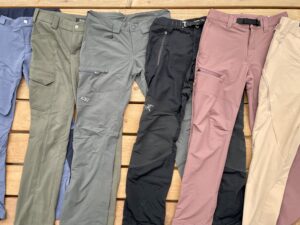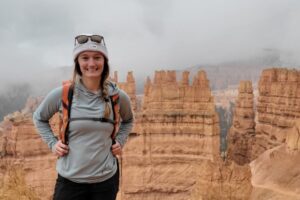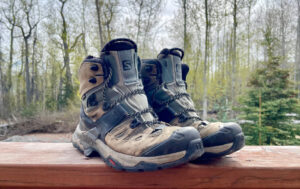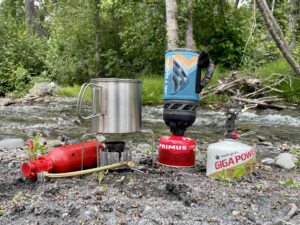Unlike a tent, the best bivy sacks add negligible load to your backpack. They are extremely useful in the backcountry and the alpine. Sometimes, you may not plan to spend the night out but know that there’s a chance. This is where bivy sacks shine. They offer an excellent lightweight shelter with low pack weight and extra protection when you unexpectedly have to sleep outside till morning.
Wondering which shelter is best? After months of testing and researching, we’ve rounded up some of the best ultralight bivy sacks.
The best bivy sacks
Editor’s choice: ORTOVOX Bivy Sack Single

- Windproof
- Dirt and water resistant
- Orange color for visibility
Pros
- Easy to use
- Great for light rain
- Works well as a sleeping bag cover
Cons
- Not totally waterproof
- Not the fastest to put away
The ORTOVOX Bivy Sack Single is a simple, easy-to-use, weather-resistant bivy bag for use as a sleeping bag cover or as an emergency shelter. This lightweight sack weighs in at 9.8oz and the stuff sack ensures the bag takes up minimal space in your pack. The 70D polyester ripstop outer is water-resistant, dirt-resistant, and windproof.
I used this bivy bag as a sleeping bag cover on a nice night in North Cascades National Park and for a cowboy camping night in the Mount Hood National Forest. I’ve also popped this alpine bivy in my bag for several ski tours but thankfully didn’t have to pull it out.
With some patience, it’s not too hard to get back into the stuff sack but it does take a moment. Overall, I love this bivy for its ease of use, light weight, and orange exterior, which could come in handy in an emergency.
See ORTOVOX Bivy Sack Single on ORTOVOX
Most bang for your buck: Go Time Gear Life Bivy Emergency Bivy Sack

- Mylar lining
- Waterproof and windproof
- Bright color so you can easily be spotted
- Emergency whistle
Pros
- Excellent visibility
- Great for cold weather
- Great for ultralight backpackers and alpinists
Cons
- May not perform well in stormy weather
- One of the best emergency bivy models but not a substitute for a sleeping bag
The Go Time Gear Life Emergency Bivy Sack is a low-cost, lightweight bivy that is great for use in an emergency. We don’t recommend this option for windy or stormy nights but it does have a mylar lining to reflect 90% of your body heat back to you, ensuring you stay warm in chilly temps. It also weighs a mere 4.1oz, making it a minimalist bivy.
We love the potentially life-saving emergency features. The bright reddish-orange color helps rescuers spot you and the bag comes with a loud emergency whistle. In cold weather camping scenarios, this is an excellent emergency bivy.
See Go Time Gear Life Bivy Emergency Bivy Sack on Amazon
See Go Time Gear Life Bivy Emergency Bivy Sack on Walmart
Great all-rounder: Snugpak Stratosphere Bivy Shelter

- 100% waterproof
- Windproof
- Supplied with a set of 10 pegs
- Head canopy with mosquito net
- Basic repair kit included
Pros
- Easy to erect in under a minute
- Roomy interior with plenty of head clearance
- Meshed ventilation section
Cons
- Heavier than average
- Not as breathable as we’d like
The Snugpak Stratosphere is a one-man bivy shelter with the features of a small tent. It is easy to erect and has a spacious interior with plenty of headspace, there’s even room to accommodate your backpack.
Ideal for lightweight hiking in all seasons, the Stratosphere provides a five-star shelter from the rain; it has a mosquito net for warmer nights and a mesh ventilation section designed to ensure a comfortable sleep all year round.
See Snugpak Stratosphere Bivy Shelter on Amazon
Most like a sleeping bag: S.O.L. 70% Reflective Escape Bivy

- Ultra-lightweight construction
- 70% heat reflectivity
- Breathable Escape material
- Water-resistant construction
Pros
- Compact and lightweight
- Durable and reusable Escape fabric promotes breathability while blocking outside moisture
- Low-visibility OD Green color well camouflaged
- Available in multiple styles
Cons
- Water-resistant but not waterproof
- The interior is quite tight
The SOL 70% Reflective Escape Bivy is great in mild climate zones. This ultralight shelter boasts an anti-condensation construction in a proprietary fabric that lets moisture escape while keeping light rain and dew out. A drawstring hood closure and water-resistant seams seal out the elements, while the side zipper allows you to use the shelter as a traditional sleeping bag.
It is a minimalist, reusable sleeping bag or blanket that still provides decent weather protection in light rain.
See S.O.L. 70% Reflective Escape Bivy on Amazon
See S.O.L. 70% Reflective Escape Bivy on Walmart
Comfort first: Sierra Designs Backcountry Bivy Sack

- Waterproof fabric
- Mesh window panel
- Spacious interior
Pros
- Ultra-portable sack folds to compact dimensions
- A breathable shell prevents moisture build-up while blocking rain and dew
- Spacious enough to accommodate an inflatable camping pad
Cons
- The zippers may leak
The Backcountry Bivy by Sierra Designs is built with wanderers in mind. This is one of the best bivy sacks in terms of comfort; a roomy interior gives you plenty of space to move and turn freely. It even accommodates a 2.5in thick inflatable camping pad for extra comfort.
Ideal in all climate zones, it boasts a breathable shell and a mesh ventilation window. It is waterproof, and while spacious, it’s light and compact. Add a comfortable camping pillow and you may not notice a difference between this cowboy camping bivy and your bed.
See Sierra Designs Backcountry Bivy Sack on Amazon
See Sierra Designs Backcountry Bivy Sack on Sierra Designs
Best four-season bivy: Black Diamond Bipod Bivy Sack

- Freestanding single-wall bivy design
- Seam-taped waterproof fabric
- Extra-large zipper entry
- Bug-free mesh ventilation
- Trail weight 1 pound 13 ounces
Pros
- Shock-corded Easton pole improves stability during use
- Satisfactory breathability and ventilation ability
- Convenient zipper entry
- Unlike other bivy sacks on this list, this one is suitable for all seasons
Cons
- The outer seam is not factory-sealed
- Pole tends to pop out of place
Made of Todd-Tex single-wall fabric, the Bipod Bivy by Black Diamond features waterproof construction enhanced by a single-pole design that sheds weight while maximizing headroom. There is plenty of interior space.
This is one of our heavier emergency shelters but it makes a perfect four-season bivy and floats the line between a top-of-the-line one-person tent and technical sleeping bags. If you end up stranded during winter, this is the cold weather emergency bivy that you want in your pack.
See Black Diamond Bipod Bivy Sack on Moosejaw
See Black Diamond Bipod Bivy Sack on Black Diamond
Best bug bivy: Outdoor Research Bug Bivy

- Hydroseal waterproof floor
- Sleeping pad straps
- Delrin single-pole system
Pros
- Generous entrance area and plenty of headroom
- Lightweight and easy to carry
- Perfect for warm, dry weather
- Interior mesh pocket to store your valuables
Cons
- Somewhat tight in the shoulder area
- Suitable only for warm, dry conditions
The Bug Bivy by Outdoor Research is the best bivy sack for stargazers who don’t want to have their vision impaired by a tiny mesh window. More than a bivy, this is a bivy-like bug net developed to keep creepy crawlies away from your sleeping area. You won’t get any cold or weather protection from this thing, but the durable Hydroseal-coated floor will still prevent ground moisture from getting in your sack.
Because of their waterproof construction, many bivy sacks tend to hold condensation which can affect their breathability. But not this lightweight mesh bug bivy! We love this model for warm summer nights when storms aren’t an issue.
See Outdoor Research Bug Bivy on Amazon
See Outdoor Research Bug Bivy on Backcountry
Best ultralight bivy: MSR E-Bivy Ultralight

- Made from silicone-coated fabric
- Waterproof and windproof
- Xtreme Shield-coated waterproof floor
- Three-year manufacturer’s warranty
Pros
- Packs down small
- Super lightweight
- Protects against the elements
- Suitable for tall people
Cons
- Hard to pack away and compress after use
Double up with this and a sleeping bag, and you should be able to sleep comfortably pretty much anywhere. It’s super lightweight at a mere seven ounces, packs down to seven by four inches, and is 88in long when it’s unpacked. You should be able to fit it into your backpack without much hassle. The silicone-coated fabric top blocks out wind, dew, and spindrift, and it has an Xtreme Shield-coated waterproof floor.
See MSR E-Bivy Ultralight on Amazon
See MSR E-Bivy Ultralight on MSR
See MSR E-Bivy Ultralight on Moosejaw
Budget buy: Tact Bivvy 2.0 Emergency Sleeping Bag

- Made from HeatEcho reflective polyester film
- Waterproof and windproof
- Retains 90% of body heat
- Para-tinder paracord
Pros
- Competitively priced
- Small enough to fit in your pack
- Comes with a para-tinder paracord
- Will keep you warm
Cons
- Difficult to pack away small
The Tact Bivvy 2.0 Emergency Sleeping Bag is a budget bivy sack to use as a backup. If you’re planning to use a bivy sack multiple nights in a row, this isn’t the ideal choice. It’s not durable enough and is somewhat difficult to pack away. However, if you want an emergency bivy to keep in your pack, this is perfect. It’s made from HeatEcho reflective polyester film that retains 90% of your body heat. Plus, it’s completely waterproof and windproof.
See Tact Bivvy 2.0 Emergency Sleeping Bag on Amazon
See Tact Bivvy 2.0 Emergency Sleeping Bag on Walmart
Why trust us
Our team has a great deal of outdoor experience. We understand that a tent with extra space isn’t right for every adventure and that bivy sacks are an excellent alternative.
Who this is for
This guide is ideal for backcountry enthusiasts, mountaineers, and rock climbers. There are so many of us who love the mountains and an emergency shelter with weather resistance is a vital piece of gear.
How we picked
We started with our personal favorites and best sellers. Then, we wanted to ensure that each bivy had weather resistance and protection from the elements. We also know people will use bivy sacks in a variety of environments and conditions so we considered bags for cold weather, heavy rain, summer months, and more. We know some folks may need a bug net bivy sack to keep away summer mosquitoes while others will need a completely waterproof four-season bivy for extreme weather.
How we tested
Mountain gear must be tested in the mountains, and that’s exactly what we did here. Testing involved a light day camping at a medium altitude and then a bigger test in North Cascades National park while alpine climbing.

Features to look for in bivy sacks
Material
A bivy sack’s material is perhaps the most essential feature to look for unless you want to wake up soaked in condensation. The most popular fabrics are:
- Gore-tex: the most popular material used to manufacture camping gear and equipment. It consists of multiple layers of laminate fabric with droplet-sized pores that ward off condensation while waterproofing the outer membrane. The material is also windproof and breathable.
- Todd-tex: is a proprietary fabric very similar to Gore-tex. This material developed by Bibler tents is also fireproof and perfect to use near a bonfire on a cooler night.
- Pertex: an innovative fabric that uses capillary action to keep your shelter dry. The fabric consists of a layer of larger filaments that absorb moisture and push it toward the exterior, where smaller fibers promote evaporation.
Besides these three popular options, the market offers a host of bivy sacks made of other high-quality materials, including Silnylon, eVent, and Sympatex.
Size
A compact bivy sack might be fantastic on a calm, blissful night, but if a storm strikes, the protection of a domed roof over your head may provide better protection. Consider your hiking habits before deciding on a mummy-style design or a roomier domed bivy.
Weight
Portability is a vague concept to define. Ten pounds is featherweight when you don’t have to carry it on your shoulders, but it can easily transform into a burden in your pack. Luckily, there are plenty of quality options that weigh 15 ounces or less. Heavy-duty models designed for extreme weather may reach up to 40 ounces, but only a few bivy sacks exceed this threshold.
Compressibility
Alongside weight and size, you must also consider how compact the bivy compresses. If you’re the adventurer type who hikes with nothing but his or her backpack, a mummy-style bivy could be your best bet. Compressing more or less as a lightweight sleeping bag, it occupies very little space in your baggage. Domed bivies also compress compactly, but the ground pegs, guy ropes, and various accessories add bulk.
Warmth
If you’re aiming for year-round protection, you should choose a shelter designed for all conditions and weather. Heavy-duty all-year models act as a protective membrane that can boost your sleeping sack’s temperature resistance by up to 10°F.
Comfort
The comfort of a bivy sack is a questionable matter. Are you a military veteran accustomed to sleeping in swamps? Then a bivy will feel like a four-star luxury. Do you need a thick air mattress, a cushioned pad, and fluffy blankets to feel some degree of enjoyment when sleeping outdoors? Maybe you’re better off with a tent.
Waterproofness
While the material of your bivy has to be breathable to promote condensation, it must also prevent outside moisture from getting in. DuraShield-coated floors help, but you should also ensure all seams and zipper areas are fabric-sealed against leaks.
Weatherproofness
A gale-proof shelter can keep you sleeping no matter what the weather throws at you. Besides waterproofness, make sure the material is windproof and at least somewhat breathable. Ventilation panels are a must in the warmer months.
Durability
The best bivy sacks are those that last years. The quality of the material impacts durability, but you should also check the sturdiness of the stitches, zippers, and seams.
Features
Besides the factors mentioned above, a great bivy sack should also have:
- Insect protection: keeps crawling creatures away from your sleeping area and lets you enjoy the breeze on warmer nights without swallowing bugs.
- Interior pocket: bivy sacks are typically too minimalist to accommodate anything other than the occupant. But an interior pocket may come in handy if you want to keep your valuables close.
- Compression sack: to pack your bivy when not in use.
- Factory-sealed seams: because they are 100% waterproof.
- Straps: let you secure your sleeping pad, improving the camping experience.

Bivy sack FAQ
Q: What is a bivy sack?
A bivy, or bivouac sack, is a one-person minimalist tent replacement. It was invented to serve climbers as a sleeping bag weatherproof shell, though early models were little more than water-resistant.
Today’s bivies incorporate multiple features designed to increase comfort and provide all-weather protection.
A modern bivy consists of a two-tier construction with a durable, waterproof, and breathable top usually made of laminate materials like Gore-Tex and a bottom tier made of ripstop nylon coated with an impermeable layer of urethane, the same material used for the tent floors.
The mummy-style bivy bring a few changes to the original design. These are equipped with zippers and mesh ventilation systems that allow mountaineers to camp comfortably all year round. If you’re happy with carrying an extra pound but crave wiggling space, a bivy shelter comes with more headspace and roomier shoulder and leg areas.
Q: When to choose a bivy sack instead of a tent?
Bivy bags are less comfortable than a full-size tent, so why should you invest in one? Well, if you’re a passionate climber looking to conquer the highest summits, a lightweight and compact bivy reduces pack weight and helps you climb faster. It’s also faster to set up, and faster to dismantle.
Sometimes, you may be planning to complete an objective in a single day but know that there is a chance of having to stay overnight; this is a great time to pack a bivy sack so you’re prepared for the worst.
Q: How to prevent condensation inside a bivy sack?
The best bivy sacks come with mesh ventilation panels designed to reduce condensation, while breathable fabrics help disperse retained moisture. The best way to reduce condensation inside your sleeping area is by keeping the ventilation panels open. When it rains, manually venting a zipper or flap also helps reduce condensation.
Q: How to wash a bivy sack?
Outdoor expeditions are fun but they can leave you rather stinky. When your bivy gets wet and dirty, it’s time to wash it.
Most bivies are made of machine-washable fabrics. Just unzip the bag and bring the slider halfway up to prevent it from coming off during the cycle. Wash with mild detergent and warm water, following the indications on the product’s label. Double rinse to remove all traces of detergent.
Line dry or tumble dry your sleeping gear on a gentle cycle to prevent damaging the fabric or the shelter’s structure. Before cleaning your sleeping bag or bivy sack, look at the manufacturer’s recommendations.
Sources:
- How to Choose Bivy Sacks – REI






